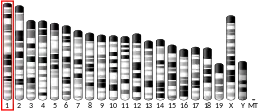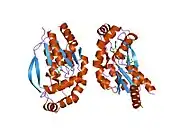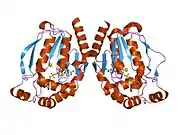| UCK2 | |||||||||||||||||||||||||||||||||||||||||||||||||||
|---|---|---|---|---|---|---|---|---|---|---|---|---|---|---|---|---|---|---|---|---|---|---|---|---|---|---|---|---|---|---|---|---|---|---|---|---|---|---|---|---|---|---|---|---|---|---|---|---|---|---|---|
 | |||||||||||||||||||||||||||||||||||||||||||||||||||
| |||||||||||||||||||||||||||||||||||||||||||||||||||
| Identifiers | |||||||||||||||||||||||||||||||||||||||||||||||||||
| Aliases | UCK2, TSA903, UK, UMPK, uridine-cytidine kinase 2 | ||||||||||||||||||||||||||||||||||||||||||||||||||
| External IDs | OMIM: 609329 MGI: 1931744 HomoloGene: 40850 GeneCards: UCK2 | ||||||||||||||||||||||||||||||||||||||||||||||||||
| |||||||||||||||||||||||||||||||||||||||||||||||||||
| |||||||||||||||||||||||||||||||||||||||||||||||||||
| |||||||||||||||||||||||||||||||||||||||||||||||||||
| |||||||||||||||||||||||||||||||||||||||||||||||||||
| |||||||||||||||||||||||||||||||||||||||||||||||||||
| Wikidata | |||||||||||||||||||||||||||||||||||||||||||||||||||
| |||||||||||||||||||||||||||||||||||||||||||||||||||
Uridine-cytidine kinase 2 (UCK2) is an enzyme that in humans is encoded by the UCK2 gene.[5]
The protein encoded by this gene catalyzes the phosphorylation of uridine and cytidine to uridine monophosphate (UMP) and cytidine monophosphate (CMP), respectively. This is the first step in the production of the pyrimidine nucleoside triphosphates required for RNA and DNA synthesis. In addition, an allele of this gene may play a role in mediating nonhumoral immunity to Hemophilus influenzae type B.[5]
Structure and mechanism
Uridine-cytidine kinase 2 is a tetramer with molecular mass of about 112 kDa.[6] In the UCK2 monomer, the active site is composed of a five-stranded β-sheet, surrounded by five α-helices and a β-hairpin loop.[7] The β-hairpin loop in particular forms a significant portion of a deep binding pocket for the uridine/cytidine substrate to moderate binding and release of substrate and products. Binding specificity for nucleosides is determined by the His-117 and Tyr-112 residues, which hydrogen bond with the 4-amino group or the 6-oxo group of cytidine and uridine, respectively.[7] A magnesium ion is coordinated in the active site by Glu-135, Ser-34, and Asp-62.

The Asp-62 residue is responsible for the catalytic activity in the enzyme active site;[8] the acidic side chain of the Asp-62 residue deprotonates the 5’-hydroxyl group on the substrate and activates it to attack the γ-phosphorus of ATP.[9] Structural analyses have shown that the side chain of the catalytic Asp-62 changes conformation before and after the reaction. It has been suggested that this conformational change occurs following phosphorylation, with the negatively charged Asp-62 moving away from the newly attached 5’-phosphate of the UMP/CMP product.[7]
Substrate specificity
Though uridine and cytidine are the physiologically preferred substrates for the enzyme, UCK2 has been shown to phosphorylate other nucleoside analogues. Examples of successfully phosphorylated substrates include 6-azauridine, 5-azacytidine, 4-thiouridine, 5-fluorocytidine, and 5-hydroxyuridine.[10] Alternatively to ATP, GTP has been shown to act comparably as a phosphate donor.[11] This promiscuity enables the important role for UCK2 as an in vivo activator of clinically active nucleoside prodrugs, such as cylcopentenylcytidine.[12]
Despite flexibility for different nucleoside analogs, UCK is unique among other nucleic acid kinases in its specificity for ribose analogs over 2’-deoxyribose forms; whereas other proteins in the NMP kinase family will indiscriminately phosphorylate both deoxyribonucleosides and ribonucleosides, UCK2 only accepts ribonucleosides.[6] This unique selectivity can be induced fit mechanisms and structural features that are unique to UCK2 among the NMP kinase family. Studies have shown that the binding of the cytidine/uridine sugar moiety results in the conformational change to reduce the distance between the His-117 and Arg-176 residues. Without the 2’-hydroxyl group on the sugar moiety, hydrogen bonding with Asp-84 and Arg-166 will be greatly reduced, resulting in diminished conformational change and weakened substrate binding.[6]
Physiological role

UCK2 is one of two human uridine-cytidine kinases. The other UCK protein is uridine-cytidine kinase 1, which shares about 70% sequence identity with UCK2.[7] While UCK1 is expressed ubiquitously in a variety of healthy tissues including the liver, skeletal muscle, and heart, UCK2 has only been detected in placental tissue.[10] UCK2, however, is of particular scientific interest due to its overexpression in tumor cell lines,[13] which makes it a target in anti-cancer treatments.
Studies determining the Michaelis-Menten kinetic parameters for these enzymes revealed that UCK2 had a four to sixfold higher binding affinity, faster maximal rates, and greater efficiencies for uridine and cytidine substrates than did UCK1.[10]
Both uridine-cytidine kinases, however, plays a crucial role in the biosynthesis of the pyrimidine nucleotides that compose RNA and DNA. Pyrimidine biosynthesis can occur through two pathways: de novo synthesis, which relies on L-glutamine as the pathway precursor, and salvage, which recycles cellular uridine and cytidine.[14] UCK2 catalyzes the first step of pyrimidine salvage, and is the rate limiting enzyme in the pathway.[15]
Disease relevance
UCK1 is expressed ubiquitously in healthy tissue, but found in low levels in tumor tissues. Conversely, UCK2 has been detected mostly in cancerous cells and healthy placental tissue. The selective expression in target tissues has resulted in the identification of UCK2 as a target in anti-cancer therapies.[16]
One strategy for anti-cancer and anti-viral therapies involves using UCK2 to activate anti-tumor prodrugs through phosphorylation.[17] As an example, 1-(3-C-ethynyl-β-D-ribopentofuranosyl)cytosine (ECyd) and 1-(3-C-ethynyl-β-D-ribopentofuranosyl)uridine (EUrd) are RNA polymerase inhibitors that are under investigation for use as anticancer drugs.[18] The nucleoside, however, only gains its clinical activity after three phosphorylations; therefore, UCK2 plays a key role in initiating the activation of the drug. An alternate strategy involves inhibition of UCK2 to block pyrimidine salvage in cancerous cells.[19] In certain cancer cell lines, pyrimidine biosynthesis primarily occurs through the salvage pathway.[20] Blocking pyrimidine salvage can prevent DNA and RNA biosynthesis, resulting in reduced cell proliferation.
Interactive pathway map
Click on genes, proteins and metabolites below to link to respective articles.[§ 1]
- ↑ The interactive pathway map can be edited at WikiPathways: "FluoropyrimidineActivity_WP1601".
References
- 1 2 3 GRCh38: Ensembl release 89: ENSG00000143179 - Ensembl, May 2017
- 1 2 3 GRCm38: Ensembl release 89: ENSMUSG00000026558 - Ensembl, May 2017
- ↑ "Human PubMed Reference:". National Center for Biotechnology Information, U.S. National Library of Medicine.
- ↑ "Mouse PubMed Reference:". National Center for Biotechnology Information, U.S. National Library of Medicine.
- 1 2 "Entrez Gene: UCK2 uridine-cytidine kinase 2".
- 1 2 3 Suzuki NN, Koizumi K, Fukushima M, Matsuda A, Inagaki F (May 2004). "Structural basis for the specificity, catalysis, and regulation of human uridine-cytidine kinase". Structure. 12 (5): 751–64. doi:10.1016/j.str.2004.02.038. PMID 15130468.
- 1 2 3 4 Appleby TC, Larson G, Cheney IW, Walker H, Wu JZ, Zhong W, Hong Z, Yao N (March 2005). "Structure of human uridine-cytidine kinase 2 determined by SIRAS using a rotating-anode X-ray generator and a single samarium derivative". Acta Crystallographica Section D. 61 (Pt 3): 278–84. Bibcode:2005AcCrD..61..278A. doi:10.1107/s0907444904032937. PMID 15735337.
- ↑ Sierra H, Cordova M, Chen CJ, Rajadhyaksha M (February 2015). "Confocal imaging-guided laser ablation of basal cell carcinomas: an ex vivo study". The Journal of Investigative Dermatology. 135 (2): 612–615. doi:10.1038/jid.2014.371. PMC 4289436. PMID 25178106.
- ↑ Tomoike F, Nakagawa N, Kuramitsu S, Masui R (December 2015). "Structural and Biochemical Studies on the Reaction Mechanism of Uridine-Cytidine Kinase" (PDF). The Protein Journal. 34 (6): 411–20. doi:10.1007/s10930-015-9636-8. PMID 26510656. S2CID 23869822.
- 1 2 3 Van Rompay AR, Norda A, Lindén K, Johansson M, Karlsson A (May 2001). "Phosphorylation of uridine and cytidine nucleoside analogs by two human uridine-cytidine kinases". Molecular Pharmacology. 59 (5): 1181–6. doi:10.1124/mol.59.5.1181. PMID 11306702. S2CID 9290273.
- ↑ Koizumi K, Shimamoto Y, Azuma A, Wataya Y, Matsuda A, Sasaki T, Fukushima M (September 2001). "Cloning and expression of uridine/cytidine kinase cDNA from human fibrosarcoma cells". International Journal of Molecular Medicine. 8 (3): 273–8. doi:10.3892/ijmm.8.3.273. PMID 11494055.
- ↑ Kang GJ, Cooney DA, Moyer JD, Kelley JA, Kim HY, Marquez VE, Johns DG (January 1989). "Cyclopentenylcytosine triphosphate. Formation and inhibition of CTP synthetase". The Journal of Biological Chemistry. 264 (2): 713–8. doi:10.1016/S0021-9258(19)85001-9. PMID 2910861.
- ↑ Schumacher FR, Wang Z, Skotheim RI, Koster R, Chung CC, Hildebrandt MA, Kratz CP, Bakken AC, Bishop DT, Cook MB, Erickson RL, Fosså SD, Greene MH, Jacobs KB, Kanetsky PA, Kolonel LN, Loud JT, Korde LA, Le Marchand L, Lewinger JP, Lothe RA, Pike MC, Rahman N, Rubertone MV, Schwartz SM, Siegmund KD, Skinner EC, Turnbull C, Van Den Berg DJ, Wu X, Yeager M, Nathanson KL, Chanock SJ, Cortessis VK, McGlynn KA (July 2013). "Testicular germ cell tumor susceptibility associated with the UCK2 locus on chromosome 1q23". Human Molecular Genetics. 22 (13): 2748–53. doi:10.1093/hmg/ddt109. PMC 3674801. PMID 23462292.
- ↑ Deans RM, Morgens DW, Ökesli A, Pillay S, Horlbeck MA, Kampmann M, Gilbert LA, Li A, Mateo R, Smith M, Glenn JS, Carette JE, Khosla C, Bassik MC (May 2016). "Parallel shRNA and CRISPR-Cas9 screens enable antiviral drug target identification". Nature Chemical Biology. 12 (5): 361–6. doi:10.1038/nchembio.2050. PMC 4836973. PMID 27018887.
- ↑ Anderson E, Brockman R (1964). "Feedback onhibition of uridine kinase by cytidine triphosphate and uridine triphosphate". Biochimica et Biophysica Acta (BBA) - Specialized Section on Nucleic Acids and Related Subjects. 91 (3): 380–386. doi:10.1016/0926-6550(64)90067-2. PMID 14254009.
- ↑ Shimamoto Y, Koizumi K, Okabe H, Kazuno H, Murakami Y, Nakagawa F, Matsuda A, Sasaki T, Fukushima M (2002-07-01). "Sensitivity of Human Cancer Cells to the New Anticancer Ribo-nucleoside TAS–106 Is Correlated with Expression of Uridine-cytidine Kinase 2". Japanese Journal of Cancer Research. 93 (7): 825–833. doi:10.1111/j.1349-7006.2002.tb01325.x. PMC 5927072. PMID 12149149.
- ↑ Golitsina NL, Danehy FT, Fellows R, Cretton-Scott E, Standring DN (March 2010). "Evaluation of the role of three candidate human kinases in the conversion of the hepatitis C virus inhibitor 2'-C-methyl-cytidine to its 5'-monophosphate metabolite". Antiviral Research. 85 (3): 470–81. doi:10.1016/j.antiviral.2009.10.020. PMID 19883694.
- ↑ Murata D, Endo Y, Obata T, Sakamoto K, Syouji Y, Kadohira M, Matsuda A, Sasaki T (October 2004). "A crucial role of uridine/cytidine kinase 2 in antitumor activity of 3'-ethynyl nucleosides". Drug Metabolism and Disposition. 32 (10): 1178–82. doi:10.1124/dmd.104.000737. hdl:2297/2651. PMID 15280220. S2CID 26650853.
- ↑ Malami I, Abdul AB, Abdullah R, Bt Kassim NK, Waziri P, Christopher Etti I (April 2016). "In Silico Discovery of Potential Uridine-Cytidine Kinase 2 Inhibitors from the Rhizome of Alpinia mutica". Molecules. 21 (4): 417. doi:10.3390/molecules21040417. PMC 6274218. PMID 27070566.
- ↑ van den Berg AA, van Lenthe H, Busch S, de Korte D, van Kuilenburg AB, van Gennip AH (August 1994). "The roles of uridine-cytidine kinase and CTP synthetase in the synthesis of CTP in malignant human T-lymphocytic cells". Leukemia. 8 (8): 1375–8. PMID 8057676.
Further reading
- Satlin A, Kucherlapati R, Ruddle FH (1976). "Assignment of the gene for human uridine monophosphate kinase to chromosome 1 using somatic cell hybrid clone panels". Cytogenetics and Cell Genetics. 15 (3): 146–52. doi:10.1159/000130513. PMID 172293.
- Jamil TP, Swallow DM, Povey S (December 1978). "A comparative study of the age-related patterns of decay of some nucleoside monophosphate kinases in human red cells". Biochemical Genetics. 16 (11–12): 1219–32. doi:10.1007/BF00484542. PMID 220950. S2CID 36455903.
- Ozaki K, Kuroki T, Hayashi S, Nakamura Y (September 1996). "Isolation of three testis-specific genes (TSA303, TSA806, TSA903) by a differential mRNA display method". Genomics. 36 (2): 316–9. doi:10.1006/geno.1996.0467. PMID 8812458.
- Van Rompay AR, Johansson M, Karlsson A (September 1999). "Phosphorylation of deoxycytidine analog monophosphates by UMP-CMP kinase: molecular characterization of the human enzyme". Molecular Pharmacology. 56 (3): 562–9. doi:10.1124/mol.56.3.562. PMID 10462544. S2CID 22945276.
- Van Rompay AR, Norda A, Lindén K, Johansson M, Karlsson A (May 2001). "Phosphorylation of uridine and cytidine nucleoside analogs by two human uridine-cytidine kinases". Molecular Pharmacology. 59 (5): 1181–6. doi:10.1124/mol.59.5.1181. PMID 11306702. S2CID 9290273.
- Komatsu N, Kimura Y, Kido A, Oya M (December 1990). "Polymorphism of uridine monophosphate kinase: population study in Japanese and phenotyping in bloodstains". International Journal of Legal Medicine. 104 (1): 13–6. doi:10.1007/BF01816477. PMID 11453085. S2CID 34509780.
- Koizumi K, Shimamoto Y, Azuma A, Wataya Y, Matsuda A, Sasaki T, Fukushima M (September 2001). "Cloning and expression of uridine/cytidine kinase cDNA from human fibrosarcoma cells". International Journal of Molecular Medicine. 8 (3): 273–8. doi:10.3892/ijmm.8.3.273. PMID 11494055.
- Pearman AT, Castro-Faria-Neto HC, McIntyre TM, Prescott SM, Stafforini DM (October 2001). "Characterization of human UMP-CMP kinase enzymatic activity and 5' untranslated region". Life Sciences. 69 (20): 2361–70. doi:10.1016/S0024-3205(01)01322-4. PMID 11681623.
- Liou JY, Dutschman GE, Lam W, Jiang Z, Cheng YC (March 2002). "Characterization of human UMP/CMP kinase and its phosphorylation of D- and L-form deoxycytidine analogue monophosphates". Cancer Research. 62 (6): 1624–31. PMID 11912132.
- Kashuba E, Kashuba V, Sandalova T, Klein G, Szekely L (August 2002). "Epstein-Barr virus encoded nuclear protein EBNA-3 binds a novel human uridine kinase/uracil phosphoribosyltransferase". BMC Cell Biology. 3: 23. doi:10.1186/1471-2121-3-23. PMC 126255. PMID 12199906.
- Gevaert K, Goethals M, Martens L, Van Damme J, Staes A, Thomas GR, Vandekerckhove J (May 2003). "Exploring proteomes and analyzing protein processing by mass spectrometric identification of sorted N-terminal peptides". Nature Biotechnology. 21 (5): 566–9. doi:10.1038/nbt810. PMID 12665801. S2CID 23783563.
- Pasti C, Gallois-Montbrun S, Munier-Lehmann H, Veron M, Gilles AM, Deville-Bonne D (April 2003). "Reaction of human UMP-CMP kinase with natural and analog substrates". European Journal of Biochemistry. 270 (8): 1784–90. doi:10.1046/j.1432-1033.2003.03537.x. PMID 12694191.
- Suzuki NN, Koizumi K, Fukushima M, Matsuda A, Inagaki F (August 2003). "Crystallization and preliminary X-ray analysis of human uridine-cytidine kinase 2". Acta Crystallographica Section D. 59 (Pt 8): 1477–8. Bibcode:2003AcCrD..59.1477S. doi:10.1107/S0907444903011533. PMID 12876357.
- Suzuki NN, Koizumi K, Fukushima M, Matsuda A, Inagaki F (May 2004). "Structural basis for the specificity, catalysis, and regulation of human uridine-cytidine kinase". Structure. 12 (5): 751–64. doi:10.1016/j.str.2004.02.038. PMID 15130468.
- Murata D, Endo Y, Obata T, Sakamoto K, Syouji Y, Kadohira M, Matsuda A, Sasaki T (October 2004). "A crucial role of uridine/cytidine kinase 2 in antitumor activity of 3'-ethynyl nucleosides". Drug Metabolism and Disposition. 32 (10): 1178–82. doi:10.1124/dmd.104.000737. hdl:2297/2651. PMID 15280220. S2CID 26650853.
- Aldenhoven J, Chen Y, Moran C (2006). "Assignment of UCK2, ATF3 and RGS18 from human chromosome 1 to porcine chromosomes 4, 9 and 10 with somatic and radiation hybrid panels". Cytogenetic and Genome Research. 112 (3–4): 341F. doi:10.1159/000089896. PMID 16484797.











